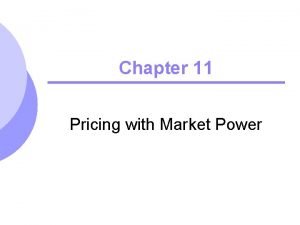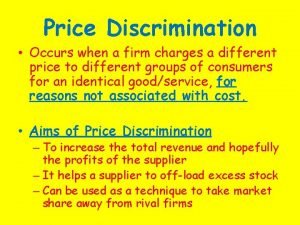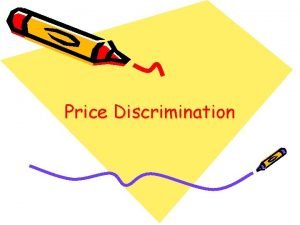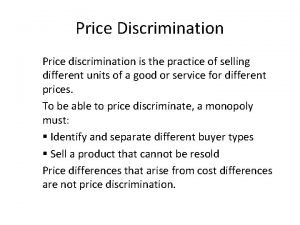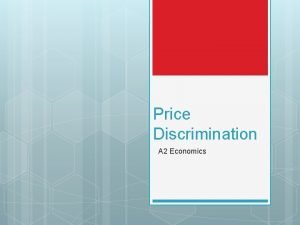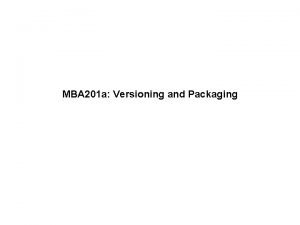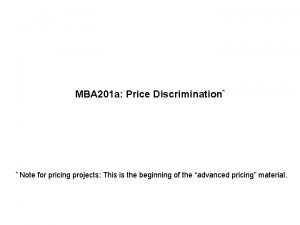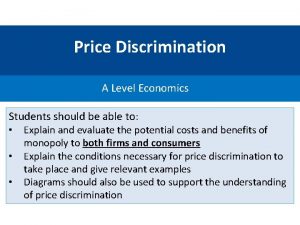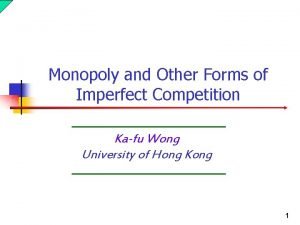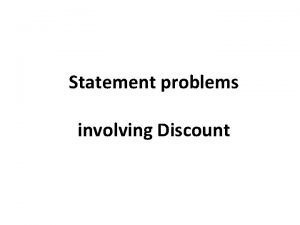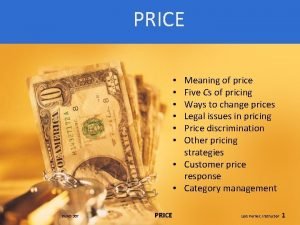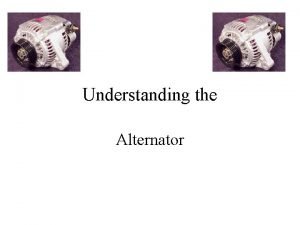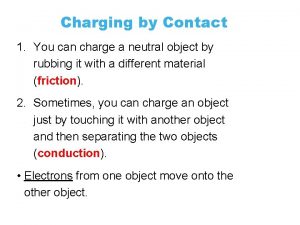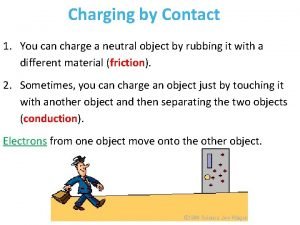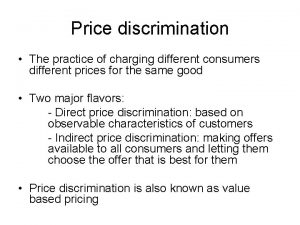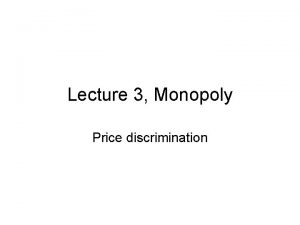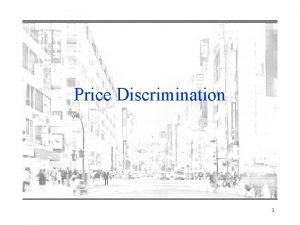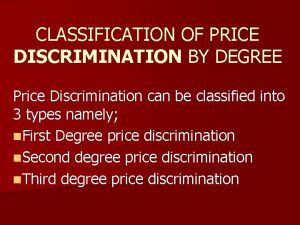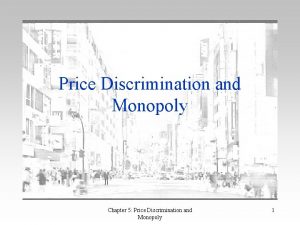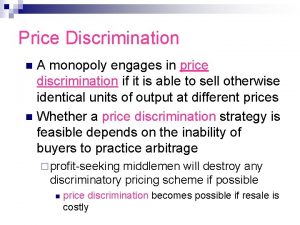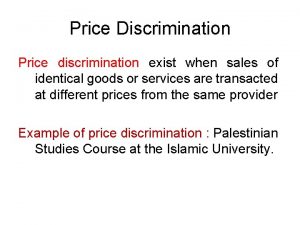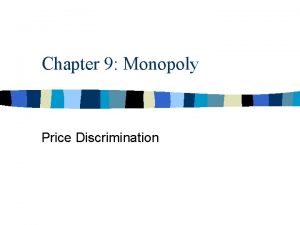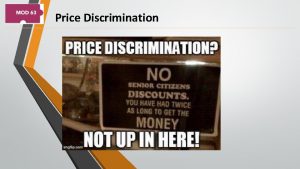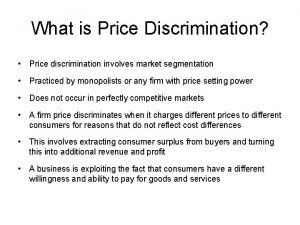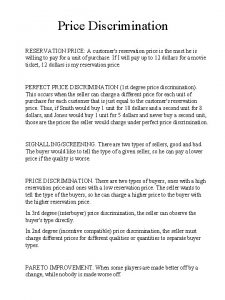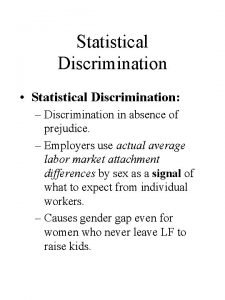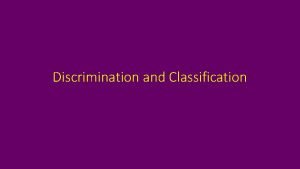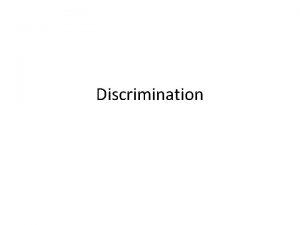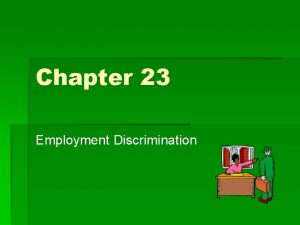Price discrimination The practice of charging different consumers































- Slides: 31

Price discrimination • The practice of charging different consumers different prices for the same good • Two major flavors: - Direct price discrimination: based on observable characteristics of customers - Indirect price discrimination: making offers available to all consumers and letting them choose the offer that is best for them • Price discrimination is also known as value based pricing

Examples • American Airlines’ yield management system • Senior-citizen discount at a movie • Discounts to airline frequent flyers • Quantity discounts such as ‘buy one and get the second at half price’ • Newspaper coupons and inserts

Issues for a long distance telephone company • What are the types of potential customers? • How will customers choose plans? • Can customers ‘mix and match’ the plans? • How will rivals react?

Illustrative examples • International pricing by pharmaceuticals • Methyl methacrylate from Rohm and Haas: arbitrage anyone? • Hand-me-down by Armani: what about snob appeal? • IBM Laser. Printer E: it can be considerably costly to offer low quality - “…IBM has gone to some expense to slow the Laser. Printer in firmware so that it can market it at a lower price” (PC Magazine, May 29, 1990) • Sony Mini. Disc

Illustrative examples • Niagara Mohawk Power Corporation: an offer you can’t refuse • IBM’s punchcard metering: a high marginal cost and a low fixed charge=illegal tying? • Buying paint from an airline

Direct price discrimination • Conceptually, the simplest pricing tool • Charge customers more or less, depending on their identity or type • Some means of identifying customers: -location -other possessions or purchases -status -age -employment -gender • The goal is to identify customers characteristics with value that customers place on the firm’s products

Conceptualizing price discrimination • The building block is the concept of price elasticity • The ‘monopoly pricing rule’ states that the profitmaximizing price-cost margin is (p-mc)/p=1/є, where є=elasticity of demand; p=price; mc=marginal cost • Clearly, the profit maximizing price is higher when demand is less elastic • A firm would like to set as price for each customer so that the monopoly pricing rule would hold for that customer’s demand

Student vs non-student prices. Price ent dem and d an em td en tud Price n-s No Stud mc Quantity

Price elasticity and competitive advantage Cost advantage (low C vs competition) Benefit advantage (high B vs competition) High price elasticity of demand • Modest price cuts gain lots of market share • Share strategy: Underprice competitors to gain share • Modest price hikes lose lots of market share • Share strategy: Maintain price parity with competitors (let benefit advantage drive share) Low price elasticity of demand • Big price cuts gain little market share • Margin strategy: Maintain price parity with competitors (let lower cost drive higher margin) • Big price hikes lose little market share • Margin strategy: Charge price premium relative to competitors.

Impediments to direct price discrimination • Informational: it is not easy to observe customer’s willingness to pay • Customers with inelastic demand have an incentive to conceal his fact • Different prices to different people create opportunities for arbitrage

Factors preventing arbitrage • Transportation costs • Legal impediments to resale • Personalized products or services • Thin markets and matching products • Informational problems

Indirect price discrimination • Major advantages -not necessary to observe consumer characteristics -arbitrage is prevented by the design of the pricing scheme

Coupons • Common method of indirect price discrimination • Work as a price discrimination tool because they are costly to use • Based on the idea that people who are more price sensitive also have a low value of time • What about in-store coupons?

Quantity discounts • These include ‘buy-one-get-one free’ offers, frequent-buyer programs etc • Few quantity discounts are based on costs • Linear or ‘two-part pricing’ schemes are sufficient for most indirect price discrimination schemes: - a fixed charge and a marginal, per unit charge

Quantity discounts • Generally a modest number of offers is adequate • The key element of the design is the prevention of arbitrage • Also, control of price-risk from frequent demand shifts is important

Risk as price discrimination • A product may be sold for $10 or for $11 with a 1% chance of winning $90 • If state lottery payouts are 50% ($1 returning 50 c), then 1% chance of winning $90 would be worth $1. 80 • Thus the bundle represents a discount of 80 c to those who like gambling • Applications to internet auctions

Product bundling • Combining two (or more) products into one • E. g. computers are often bundled with a monitor and/or printer • There is no price discrimination in Pure Bundling • Mixed Bundling is a very effective form of price discrimination • Surprisingly, like co-promotions this can be done with unrelated products also

Product bundling • Consider a business suit and a drill selling for $300 and $75 • Assume the bundled product sells for $350 • The company is simultaneously offering a discount on the suit (for drill purchasers) and on the drill (for suit purchasers) • Consider the perspective of drill purchasers

Product bundling • If the initial prices were set at the profit maximizing level, the $25 discount on suits will not make much difference to profits • The cost of the discount will be made up by more suit purchases • However, increased suit purchases also imply increased drill purchases • And that is pure profit for the firm!!

Peak-load pricing • During peak capacity utilization, selling additional units reflects cost of adding capacity • At off-peak times, incremental costs are low since no capacity needs to be added • Peak-load pricing is about allocating the costs of capacity to the relevant demand

Peak-load pricing • This is important for airlines, hotels and electricity. Peak electricity costs can easily be five times the off-peak costs • Using average cost as indicator of incremental cost is ill-advised: • Average cost will be much higher than incremental costs at off-peak times and vice versa at peak times • Thus average cost pricing (average cost plus markup) may result in losses at peak periods and inability to recover cost of capacity

Yield management in airlines • Main features: - seats reserved for full-fare passengers - discount seats are full of restrictions - there is dynamic price discrimination • Dynamic element is due to full-fare consumers appearing late in the process • Important to price the option value of the flexibility that is lost when a ticket is booked

Yield management in airlines • Let there be full fare seats and discount seats with prices and. > • When to stop selling discount seats? • Suppose q seats have been sold and Q-q remain out of a total Q • Let n be probability that next request comes from a passenger who will not pay full fare • Let s be probability that the plane sells out • Thus seat sold at a discount today will displace a full fare passenger

Yield management in airlines • Refusing to sell another discount seat produces revenue if: -next person to call will pay full fare (w. p. 1 -n) -next person will not pay full fare and the plane sells out at full fare (w. p. n(1 -s)) • It is better to sell an additional discount seat if > (1 -n+n(1 -s)) • Thus it is profitable to sell the discounted ticket if ns > • Most important fact is probability that plane is full !

Yield management in airlines • Implementation of this formula is a statistical problem of estimating n and s • This can be done through historical data or by managerial learning and judgment • From a pricing perspective the correct measure of capacity utilization is the proportion of full flights, rather then the proportion of occupied seats

Theatrical yield management • Movies have a definite venue release pattern Venue Week after theatrical release Theatrical release 0 Airlines and hotel payper-view 16 Home video 27 Home pay-per-view 34 Premium cable (HBO) 61 Network TV Substantial variation • Delay in each increases value of the former • But, can there be a credible commitment? ?

Competition and price discrimination • The attractiveness of price discrimination makes it very prevalent • Some firms use it to offer discounts to attract rival’s customers, but do not offer discounts to their own best customers • This is usually a mistake!! • The ‘best’ customers of one’s rival will usually be one’s price sensitive customers • They will require lower prices to switch • It’s much better to increase loyalty among one’s own customers

Opportunism and exclusive dealing • In B 2 B contracts, after-the-fact opportunism by sellers can be major concern • Franchisors opening new stores whenever franchisees are successful • ‘Holdup problems’ due to relationship-specific investments: e. g. , electric power plant locates close to coal mine, but afterwards the coal mine raises its prices

Solving opportunistic pricing by sellers • • • Create competition by licensing Vertically integrate with the buyers Long-term contracts Exclusive contracts Most-favored-customer clauses Uniform, simple contracts

Price dispersion and sales • Grocery stores announce sale items, and there is large variation in prices • The price varies in unpredictable ways • What explains price dispersion? • A firm sells two different consumer types -well informed about competitive prices -uninformed consumers

Price dispersion and sales • When a firm faces a mixture of consumers its prices should not be predictable to rivals • Predictable head-to-head competition for informed customers is unprofitable • Thus firms must run sales so that its prices cannot be forecast by rivals • According to theory, sales promotions represent the balancing the profit from captive consumers and the additional sales to uninformed shoppers
 Price freeze ibig sabihin
Price freeze ibig sabihin What is the third trophic level
What is the third trophic level Producers primary consumers secondary consumers
Producers primary consumers secondary consumers Peak load pricing
Peak load pricing Monopoly perfect price discrimination
Monopoly perfect price discrimination First degree price discrimination
First degree price discrimination Second degree price discrimination graph
Second degree price discrimination graph Price discrimination occurs when a firm
Price discrimination occurs when a firm Price discrimination real world examples
Price discrimination real world examples Student discount price discrimination
Student discount price discrimination Perfect price discrimination
Perfect price discrimination Objectives of price discrimination
Objectives of price discrimination Price is greater than marginal cost in monopoly
Price is greater than marginal cost in monopoly Versioning price discrimination
Versioning price discrimination Explain price discrimination
Explain price discrimination Hurdle model of price discrimination
Hurdle model of price discrimination What is calculus
What is calculus Marked price-selling price=
Marked price-selling price= What is hire purchase system
What is hire purchase system Sap strategic sourcing
Sap strategic sourcing Price discovery and price determination
Price discovery and price determination In the five c's, how is cost different from price?
In the five c's, how is cost different from price? How to reset et 500 gate motor
How to reset et 500 gate motor Alternator charging system diagram
Alternator charging system diagram Energy density of solenoid
Energy density of solenoid Rac charging stations
Rac charging stations Tesla charging stations in montana
Tesla charging stations in montana Temporary induction
Temporary induction Charging by conduction
Charging by conduction Charging by contact
Charging by contact Charging toward cleaner air in london
Charging toward cleaner air in london Capacitor discharge equation
Capacitor discharge equation






